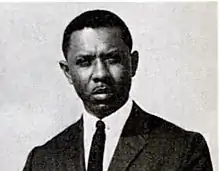Leon Quincy Jackson | |
|---|---|
 | |
| Born | January 9, 1927, or alternatively January 9, 1926 Wewoka, Oklahoma, U.S.[1] |
| Died | July 21, 1995 Nashville, Tennessee, U.S. |
| Burial place | Greenwood Cemetery |
| Other names | L. Quincy Jackson |
| Education | Wilberforce University, Iowa State University |
| Alma mater | Kansas State University, University of Oklahoma |
| Occupation(s) | Architect, professor |
| Movement | Modernism |
| Children | 1 |
Leon Quincy Jackson (January 9, 1926,[1] or 1927–July 21, 1995),[2] was an American architect and professor. He was known for his modernist building designs. He is thought to be the first black architect in Oklahoma,[3] however he faced discrimination and was not able to take the state licensing exam. His architecture firm was named L. Quincy Jackson & Associates.[4]
Early life and education
Leon Quincy Jackson was born on January 9 in either 1926 or 1927 in Wewoka, Oklahoma.[1][2] He was raised by his mother Roxie Ann Jackson, a high school principal and his stepfather Lonnie Galimore, a pharmacist.[1][5] His mother was one-half Seminole and owned a large farm with oil reserves and a handful of active oil derricks.[1]
He had studied at Wilberforce University and Iowa State University.[6] Jackson received a B.A. degree in architecture (1950) from Kansas State University; and received a M.S. degree (1954) in planning from the University of Oklahoma (OU).[7][8][6] Jackson was a student of Bruce Goff.[7] He was the third black student to receive a master's degree in planning from OU.[6]
Career
In 1950, Jackson was the first African-American architect to open an office in the state of Oklahoma.[2] He was hampered in taking his Oklahoma state licensing exam because of his race.[2]
Before receiving his master's degree, Jackson taught architectural engineering at Prairie View A&M University.[6] In 1954, Haile Selassie, the Emperor of Ethiopia, visited Oklahoma State University–Stillwater in Stillwater, Oklahoma and Jackson attended the event.[9]
In 1954, Jackson moved to Nashville.[7] He taught at Tennessee State University (TSU) from 1954 until ?.[7] Jackson had established the architectural engineering program at TSU.[7] He was an influence on many students, including architect Bob Wesley.[10][11]
From 1966 until 1975, Jackson was a member of the American Institute of Architects (AIA).[12]
Death and legacy
Jackson died on July 21, 1995, and was buried in the Greenwood Cemetery in Nashville.[10] Some of his buildings have been lost to fire or demolition but others remain standing.[10]
His son, Leon Jackson (1969–2016) also trained as an architect, and worked as a promoter of electronic music in Nashville, Tennessee.[13]
List of buildings
- Jackson House, 2026 Northeast Grand Boulevard (c. 1950s), Edwards Heights Historic District, Oklahoma City, Oklahoma; his former home[6][3]
- Pagoda of Medicine (1963), former Riverside Adventist Hospital campus (now the Seventh-Day Adventist Church), 707 Youngs Lane, Nashville, Tennessee; now demolished[7][14]
- First Baptist Church, Capitol Hill (1972 remodel), Nashville, Tennessee
References
- 1 2 3 4 5 Wilson, Dreck Spurlock, ed. (2004). African American Architects (First ed.). Routledge. p. 8. doi:10.4324/9780203493120. ISBN 9780203493120. Retrieved May 17, 2021.
- 1 2 3 4 "L. Quincy Jackson - Architect". Docomomo-us.org. Retrieved May 17, 2021.
- 1 2 "National Register of Historic Places Inventory/Nomination: Edwards Heights Historic District". National Park Service. September 7, 2005. Retrieved January 24, 2023. With accompanying pictures
- ↑ Directory, African American Architects. Center for the Study of the Practice of Architecture, College of Design, Architecture, Art and Planning, University of Cincinnati. 1995. p. 57.
- ↑ "Roxie Gallimore". The Daily Oklahoman. January 21, 1978. p. 23. Retrieved January 25, 2023.
- 1 2 3 4 5 "Receives Masters in Architecture". The Black Dispatch. September 11, 1954. p. 1. Retrieved January 25, 2023.
- 1 2 3 4 5 6 "Pagoda of Medicine". Historic Nashville, Inc. July 7, 2016. Retrieved January 25, 2023.
- ↑ "Black History Month Feature: L. Quincy Jackson". Christopher C. Gibbs College of Architecture, University of Oklahoma. February 9, 2022. Retrieved January 25, 2023.
- ↑ "They Touched The Hem of His Garment". The Black Dispatch. June 26, 1954. p. 1. Retrieved January 25, 2023.
- 1 2 3 "Historical structure destroyed in early morning fire". KFOR. August 23, 2013.
- ↑ Lift Every Voice: A Celebration of Black Lives. Hearst Home & Hearst Home Kids. April 26, 2022. p. 99. ISBN 978-1-950785-61-2.
- ↑ "L[eon] Quincy Jackson architect". Archinform.net.
- ↑ Maloney, Sean L (November 29, 2016). "Leon Jackson, 1969-2016: Local Electronic Music Community Remembers a Pioneer". Nashville Scene. Retrieved May 17, 2021.
- ↑ Meyer, Holly. "Historic Nashville lists nine threatened properties". The Tennessean. Retrieved January 25, 2023.